Analysis of Current and Future SPEI Droughts in the La Plata Basin Based on Results from the Regional Eta Climate Model
Abstract
:1. Introduction
2. Materials and Methods
2.1. Data and Regional Extent
2.2. Data Analysis
2.3. Limitations of the Methodology
3. Results
3.1. Precipitation and Evapotranspiration
3.2. Three-Month SPEI (SPEI3)
3.3. Seasonal Drought Aspects (Time, Severity, Area and Frequency)
4. Discussion
5. Conclusions
- The changes of P and PET (compared to the current period 1961–2005) for the nearest future scenario 2011–2040 showed a marked north–south spatial pattern within the basin. Our results envisage a decrease of rainfall in the north (negative changes of P) but an increase in the south (positive changes of P), and the opposite for PET. An increase of both P and PET (positive changes) are projected for the periods 2041–2070 and 2070–2099 across the whole basin.
- Based on the climate projections, we expect that the north of La Plata Basin will be characterized by an increase of droughts, whereas the south will be dominated by alternating wet and dry periods, during 2011–2040. The wetter climate, however, is expected to spread from south to north in the distant future.
- The high variability of droughts in terms of space, time, and magnitude when analysing at the cell scale highlights the importance of conducting high spatial resolution studies in order to accurately project droughts on localized areas and design tailored measures.
- Only for LoPy were relevant differences in the probability of the occurrence of droughts between cropland and grassland areas found, this being higher in the former.
- Mainly in UpPy and UpPn did the projections for all climate scenarios show an increase of moderate and severe droughts over large regions dedicated to crops and grasses, while for the near future, in LoUy and PlBn the projections show a decrease of drought severity compared to the current period. These projections suggest the need for a potential relocation of certain crops from the northern regions towards cooler regions located in the centre and south, and an increase in competition among uses in these regions.
- When characterizing droughts under a changing climate, it is essential to use indices that involve the relevant climate variables in the study area. In our case, evapotranspiration highly conditions drought occurrence in the north, whereas precipitation is key in the south of the La Plata Basin, thus the SPEI was suitable for this case study.
Acknowledgments
Author Contributions
Conflicts of Interest
References
- Aquastat. Available online: http://www.fao.org/nr/aquastat (accessed on 1 September 2017).
- Viglizzo, E.F.; Frank, F.C. Land-use options for Del Plata Basin in South America: Tradeoffs analysis based on ecosystem service provision. Ecol. Econ. 2006, 57, 140–151. [Google Scholar] [CrossRef]
- Barrucand, M.G.; Vargas, W.M.; Rusticucci, M.M. Dry conditions over Argentina and the related monthly circulation patterns. Meteorol. Atmos. Phys. 2007, 98, 99–114. [Google Scholar] [CrossRef]
- Llano, M.; Penalba, O. A climatic analysis of dry sequences in Argentina. Int. J. Climatol. 2010, 31, 504–513. [Google Scholar] [CrossRef]
- Chen, J.; Wilson, C.; Tapley, B.; Longuevergne, L.; Scanlon, B. Recent La Plata basin drought conditions observed by satellite gravimetry. J. Geophys. Res. 2010, 115, D22108. [Google Scholar] [CrossRef]
- Abelen, S.; Seitz, F.; Abarca-del-Rio, R.; Güntner, A. Droughts and Floods in the La Plata Basin in Soil Moisture Data and GRACE. Remote Sens. 2015, 7, 7324–7349. [Google Scholar] [CrossRef]
- Penalba, O.; Rivera, J. Comparación de seis índices para el monitoreo de sequías meteorológicas en el Sur de Sudamérica. Meteorologica 2015, 40, 33–57. [Google Scholar]
- World Water Assessment Programme (WWAP). La Plata Basin Case Study: Final Report; UNESCO: Perugia, Italy, 2007; pp. 1–537. Available online: http://unesdoc.unesco.org/images/0015/001512/151252e.pdf (accessed on 2 November 2017).
- Penalba, O.; Vargas, W. Review: Variability of low monthly rainfall in La Plata Basin. Meteorol. Appl. 2008, 15, 313–323. [Google Scholar] [CrossRef]
- Minetti, J.L.; Vargas, W.M.; Poblete, A.G.; Acuña, L.R.; Casagrande, G. Non-linear trends and low frequency oscillations in annual precipitation over Argentina and Chile, 1931–1999. Atmosfera 2004, 16, 119–135. [Google Scholar]
- Marengo, J.; Bernasconi, M. Regional differences in aridity/drought conditions over Northeast Brazil: Present state and future projections. Clim. Chang. 2015, 129, 103–115. [Google Scholar] [CrossRef]
- Vargas, W.M.; Naumann, G.; Minetti, J.L. Dry spells in the River Plata Basin: An approximation of the diagnosis of droughts using daily data. Theor. Appl. Climatol. 2011, 104, 159–173. [Google Scholar] [CrossRef]
- Magrin, G.O.; Marengo, J.A.; Boulanger, J.P.; Buckeridge, M.S.; Castellanos, E.; Poveda, G.; Scarano, F.R.; Vicuña, S. Central and South America. In Climate Change 2014: Impacts, Adaptation, and Vulnerability. Part B: Regional Aspects; Contribution of Working Group II to the Fifth Assessment Report of the Intergovernmental Panel on Climate Change; Barros, V.R., Field, C.B., Eds.; Cambridge University Press: Cambridge, UK; New York, NY, USA, 2014; pp. 1499–1566. [Google Scholar]
- Doyle, M.E.; Saurral, R.I.; Barros, V.R. Trends in the distributions of aggregated monthly precipitation over the La Plata Basin. Int. J. Climatol. 2012, 32, 2149–2162. [Google Scholar] [CrossRef]
- Penalba, O.; Robledo, F. Spatial and temporal variability of the frequency of extreme daily rainfall regime in the La Plata Basin during the 20th century. Clim. Chang. 2010, 98, 531–550. [Google Scholar] [CrossRef]
- Dufek, A.S.; Ambrizzi, T.; Da Rocha, R.P. Are reanalysis data useful for calculating climate indices over South America? Ann. N.Y. Acad. Sci. 2008, 1146, 87–104. [Google Scholar] [CrossRef] [PubMed]
- Tucci, C. Visão dos Recursos Hídricos da Bacia do Rio da Prata; Visão Regional, Volume 1; GEF-CIC-PNUMA-OEA: Porto Alegre, Brazil, 2004; pp. 1–227. Available online: http://rhama.com.br/blog/wp-content/uploads/2017/04/REGAv3n2.pdf (accessed on 2 November 2017).
- Valente, M. Agriculture-Argentina: Worst Drought in 100 Years. IPS Online. 21 January 2009, p. 449. Available online: http://www.ipsnews.net/2009/01/agriculture-argentina-worst-drought-in-100-years/ (accessed on 2 November 2017).
- EM-DAT. International Disaster Database. OFDA/CRED, Université Catholique de Louvain: Brussels, Belgium. Available online: www.emdat.be (accessed on 1 March 2017).
- Donat, M.G.; Alexander, L.V.; Yang, H.; Durre, I.; Vose, R.; Dunn, R.J.H.; Willett, K.M.; Aguilar, E.; Brunet, M.; Caesar, J.; et al. Updated analyses of temperature and precipitation extreme indices since the beginning of the twentieth century: The HadEX2 dataset. J. Gephys. Res. 2013, 20, 1–16. [Google Scholar] [CrossRef]
- Caffera, R.M.; Berbery, E.H. La Plata Basin climatology. In Climate Change in the La Plata Basin; Barros, V., Clarke, R., Eds.; Research Centre for Sea and Atmosphere, Cima-Conicet/FCEN-UBA: Buenos Aires, Argentina, 2006; pp. 16–34. [Google Scholar]
- Penalba, O.; Rivera, J. Regional aspects of future precipitation and meteorological drought characteristics over Southern South America projected by a CMIP5 multi-model ensemble. Am. J. Clim. Chang. 2013, 2, 173–182. [Google Scholar] [CrossRef]
- Solman, S. Regional climate modelling over South America: A Review. Adv. Meteorol. 2013, 2013, 504357. [Google Scholar] [CrossRef]
- Chou, S.C.; Lyra, A.; Mourão, C.; Dereczynski, C.; Pilotto, I.; Gomes, J.; Bustamante, J.; Tavares, P.; Silva, A.; Rodrigues, D.; et al. Assessment of Climate Change over South America under RCP 4.5 and 8.5 Downscaling Scenarios. Am. J. Clim. Chang. 2014, 3, 512–527. [Google Scholar] [CrossRef]
- Llopart, M.; Coppola, E.; Giorgi, F.; da Rocha, R.; Cuadra, S. Climate change impact on precipitation for the Amazon and La Plata basins. Clim. Chang. 2014, 125, 111–125. [Google Scholar] [CrossRef]
- Marengo, J.; Chou, S.; Alves, L.; National Institute for Space Research. Personal communication, 2014.
- Mourao, C. Producto 2: Relatório Contendo a Análise das Simulações do Modelo Eta-10 km Para a Região da Bacia do Prata, Utilizando as Condições do HadGEM2-ES RCP 4.5, Para o Período de 1961–2100; Organización de Estados Americanos: Porto Alegre, Brasil, 2014; p. 28. [Google Scholar]
- Reboita, M.; Da Rocha, R.; Dias, C.; Ynoue, R. Climate Projections for South America: RegCM3 driven by HadCM3 and ECHAM5. Adv. Meteorol. 2014, 2014, 376738. [Google Scholar] [CrossRef]
- Barros, V.R.; Garavaglia, C.R.; Doyle, M.E. Twenty-first century projections of extreme precipitations in the Plata Basin. Int. J. River Basin Manag. 2013, 11, 373–387. [Google Scholar] [CrossRef]
- Menéndez, C.G.; Carril, A.F. Potential changes in extremes and links with the Southern Annular Mode as simulated by a multi-model ensemble. Clim. Chang. 2010, 98, 359–377. [Google Scholar] [CrossRef]
- Jones, C.; Carvalho, L.M.V. Climate change in the South American monsoon system: Present climate and CMIP5 projections. J. Clim. 2013, 26, 6660–6678. [Google Scholar] [CrossRef]
- Marengo, J.A.; Chou, S.C.; Kay, G.; Alves, L.M.; Pesquero, J.F.; Soares, W.R.; Santos, D.C.; Lyra, A.; Sueiro, G.; Betts, R.; et al. Development of regional future climate change scenarios in South America using the Eta CPTEC/HadCM3 climate change projections: Climatology and regional analyses for the Amazon, São Francisco and the Parana River Basins. Clim. Dyn. 2011, 38, 1829–1848. [Google Scholar] [CrossRef]
- Cavalcanti, I.F.A. Large scale and synoptic features associated with extreme precipitation over South America: A review and case studies for the first decade of the 21st century. Atmos. Res. 2012, 118, 27–40. [Google Scholar] [CrossRef]
- Cavalcanti, I.F.A.; Carril, A.F.; Penalba, O.C.; Grimm, A.M.; Menéndez, C.G.; Sanchez, E.; Cherchi, A.; Sörensson, A.; Robledo, F.; Rivera, J.; et al. Flach Precipitation extremes over La Plata Basin—Review and new results from observations and climate simulations. J. Hydrol. 2015, 523, 211–230. [Google Scholar] [CrossRef]
- Chou, S.C.; Tanajura, C.A.S.; Xue, Y.; Nobre, C.A. Validation of the coupled Eta/SSiB model over South America. J. Geophys. Res. 2002, 107, LBA56-1–LBA56-20. [Google Scholar] [CrossRef]
- Carril, A.F.; Menéndez, C.G.; Remedio, A.R.C.; Robledo, F.; Sörenson, A.; Tencer, B.; Boulanger, J.P.; de Castro, M.; Jacob, D.; Le Treut, H.; et al. Performance of a multi-RCM ensemble for South Eastern South America. Clim. Dyn. 2012, 39, 2747–2768. [Google Scholar] [CrossRef]
- Menéndez, C.G.; Zaninelli, P.; Carril, A.; Sánchez, E. Hydrological cycle, temperature, and land surface atmosphere interaction in the La Plata Basin during summer: Response to climate change. Clim. Res. 2016, 68, 231–241. [Google Scholar] [CrossRef]
- Solman, S.; Sánchez, E.; Samuelsson, R.P.; Da Rocha, C.; Marengo, J.; Pessacg, N.L.; Remedio, A.R.C.; Chou, S.C.; Berbery, H.; Le Treut, H.; et al. Evaluation of an ensemble of regional climate model simulations over South America driven by the ERA-Interim reanalysis: Model performance and uncertainties. Clim. Dyn. 2013, 41, 1139–1157. [Google Scholar]
- Menéndez, C.G.; De Castro, M.; Boulanger, J.P.; D’Onofrio, A.; Sánchez, E.; Sörenson, A.A.; Blázquez, J.; Elizalde, J.; Jacob, D.; Li, Z.X.; et al. Downscaling extreme month-long anomalies in southern South America. Clim. Chang. 2010, 98, 379–403. [Google Scholar] [CrossRef]
- Solman, S.A.; Pessacg, N.-L. Evaluating uncertainties in regional climate simulations over South America at the seasonal scale. Clim. Dyn. 2012, 39, 59–76. [Google Scholar] [CrossRef]
- Parker, W.S. Ensemble modeling, uncertainty and robust predictions. WIREs Clim. Chang. 2013, 4, 213–223. [Google Scholar] [CrossRef]
- Sánchez, E.; Solman, S.; Remedio, A.R.C.; Berbery, H.; Samuelsson, R.P.; Da Rocha, C.; Mourão, L.; Marengo, J.; De Castro, M.; Jacob, D.; et al. Regional climate modelling in CLARIS-LPB: A concerted approach towards twenty first century projections of regional temperature and precipitation over South America. Clim. Dyn. 2015, 45, 2193–2212. [Google Scholar] [CrossRef]
- Claris LPB. A Europe-South America Network for Climate Change Assessment and ImStudies in La Plata Basin. FP7-ENVIRONMENT—Specific Programme “Cooperation”: Environment (Including Climate Change). Project ID: 212492. Available online: http://cordis.europa.eu/project/rcn/89402_en.html (accessed on 2 November 2017).
- Simmons, A.; Uppala, S.; Dee, D.; Kobayashi, S. ERA-interim: New ECMWF reanalysis products from 1989 onwards. ECMWF Newsl. 2007, 110, 25–35. [Google Scholar]
- Chen, M.; Shi, W.; Xie, P.; Silva, V.B.S.; Kousky, V.E.; Higgins, R.W.; Janowiak, J.E. Assessing objective techniques for gauge-based analyses of global daily precipitation. J. Geophys. Res. 2008, 113, D04110. [Google Scholar] [CrossRef]
- Mesinger, F.; Veljovic, K.; Chou, S.C.; Gomes, J.; Lyra, A. The Eta Model: Design, Use, and Added Value. In Topics in Climate Modeling; Chapter 6; Intech: Rijeka, Croatia; Available online: http://www.intechopen.com/books/topics-in-climate-modeling (accessed on 2 November 2017).
- Chou, S.C.; Fonseca, J.F.; Gomes, J.L. Evaluation of Eta Model seasonal precipitation forecasts over South America. Nonlinear Proc. Geophys. 2005, 12, 537–555. [Google Scholar] [CrossRef]
- Mesinger, F.; Chou, S.; Gomes, J.; Jovic, D.; Bastos, P.; Bustamante, J.F.; Lazic, L.; Lyra, A.A.; Morelli, S.; Ristic, I.; et al. An upgraded version of the Eta model. Meteorol. Atmos. Phys. 2012, 116, 63–79. [Google Scholar] [CrossRef]
- Mesinger, F.; Janjic, Z.I. Noise Due to Time-Dependent Boundary Conditions in Limited Area Models. The GARP Programme on Numerical Experimentation; Rep. No. 4; WMO: Geneva, Switzerland, 1974; pp. 31–32. [Google Scholar]
- Black, T.L. The New NMC mesoscale Eta model: Description and forecast samples. Weather Forecast. 1994, 9, 256–278. [Google Scholar] [CrossRef]
- Chou, S.C.; Lyra, A.A.; Mourão, C.; Dereczynski, C.; Pilotto, I.; Gomes, J.; Bustamante, J.; Tavares, P.; Silva, A.; Rodrigues, D.; et al. Evaluation of the Eta Simulations Nested in Three Global Climate Models. Am. J. Clim. Chang. 2014, 3, 438–454. [Google Scholar] [CrossRef]
- Chou, S.; Marengo, J.; Lyra, A.A.; Sueiro, G.; Pesquero, J.F.; Alves, L.M.; Kay, G.; Betts, R.; Chagas, D.J.; Gomes, J.L.; et al. Downscaling of South America present climate driven by 4-member HadCM3 runs. Clim. Dyn. 2012, 38, 635–653. [Google Scholar] [CrossRef]
- Pesquero, J.F.; Chou, S.; Nobre, C.A.; Marengo, J.A. Climate downscaling over South America for 1961–1970 using the Eta Model. Theor. Appl. Climatol. 2010, 99, 75–93. [Google Scholar] [CrossRef]
- Bustamante, J.F.; Gomes, J.L.; Chou, S.C. 5-year Eta Model Seasonal Forecast Climatology over South America. In Proceedings of the International Conference on Southern Hemisphere Meteorology and Oceanography, Foz do Iguaçu, Brazil, 24–28 April 2006; pp. 503–506. [Google Scholar]
- Alves, L.F.; Marengo, J.A.; Chou, S.C. Avaliação das Previsões de Chuvas Sazonais do Modelo Eta Climático Sobre o Brasil. In Proceedings of the Congresso Brasiliero de Meteorologia, Fortaleza, Brazil, 29 August–13 October 2004. [Google Scholar]
- Chou, S.C.; Nunes, A.M.B.; Cavalcanti, I.F.A. Extended range forecasts over South America using the regional Eta model. J. Geophys. Res. 2000, 105, 10147–10160. [Google Scholar] [CrossRef]
- Bellouin, N.; Rae, J.; Jones, A.; Johnson, C.; Haywood, J.; Boucher, O. Aerosol forcing in the Climate Model Intercomparison Project (CMIP5) simulations by HadGEM2-ES and the role of ammonium nitrate. J. Geophys. Res. 2011, 116, 1–25. [Google Scholar] [CrossRef]
- Collins, W.J.; Bellouin, N.; Doutriaux-Boucher, M.; Gedney, N.; Halloran, P.; Hinton, T.; Hughes, J.; Jones, C.D.; Joshi, M.; Liddicoat, S.; et al. Development and evaluation of an Earth-System model HadGEM2. Geosci. Model Dev. 2011, 4, 1051–1075. [Google Scholar] [CrossRef]
- Martin, G.M.; Bellouin, N.; Collins, W.J.; Culverwell, I.D.; Halloran, P.R.; Hardiman, S.C.; Hinton, T.J.; Jones, C.D.; McDonald, R.E.; McLaren, A.J.; et al. The HadGEM2 family of Met Office Unified Model climate configurations. Geosci. Model Dev. 2011, 4, 723–757. [Google Scholar]
- University of East Anglia Climatic Research Unit (CRU). CRU TS Version 3.22. Climatic Research Unit (CRU) Time-Series Datasets of Variations in Climate with Variations in Other Phenomena; Climatic Research Unit, NCAS British Atmospheric Data Centre: Norwich, UK, 2014. [Google Scholar]
- Thomson, A.M.; Calvin, K.V.; Smith, S.J.; Kyle, G.P.; Volke, A.; Patel, P.; Delgado-Arias, S.; Bond-Lamberty, B.; Wise, M.A.; Clarke, L.E.; et al. RCP4.5: A pathway for stabilization of radiative forcing by 2100. Clim. Chang. 2011, 109, 77–94. [Google Scholar] [CrossRef]
- World Meteorological Organization (WMO) and Global Water Partnership (GWP). Handbook of Drought Indicators and Indices; Integrated Drought Management Programme (IDMP), Integrated Drought Management Tools and Guidelines Series 2; Svoboda, M., Fuchs, B.A., Eds.; WMO: Geneva, Switzerland, 2016; pp. 1–52. [Google Scholar]
- World Meteorological Organization (WMO). Standardized Precipitation Index. User Guide; World Meteorological Organization: Geneva, Switzerland, 2012; pp. 1–24. [Google Scholar]
- Vicente-Serrano, S.M.; Beguería, S.; López-Moreno, J.I. A Multi-scalar drought index sensitive to global warming: The Standardized Precipitation Evapotranspiration Index—SPEI. J. Clim. 2010, 23, 1696–1718. [Google Scholar] [CrossRef]
- Beguería, S.; Vicente-Serrano, S.M.; Angulo, M. A multi-scalar global drought data set: The SPEIbase: A new gridded product for the analysis of drought variability and impacts. Am. Meteorol. Soc. 2010, 91, 1351–1354. [Google Scholar] [CrossRef]
- Hao, Z.; Singh, V. Drought characterization from a multivariate perspective: A review. J. Hydrol. 2015, 527, 668–678. [Google Scholar] [CrossRef]
- Mishra, A.; Singh, V. Drought modeling—A review. J. Hydrol. 2011, 403, 157–175. [Google Scholar] [CrossRef]
- Mishra, A.; Singh, V. Analysis of drought severity-area-frequency curves using a general circulation model and scenario uncertainty. J. Geophys. Res. 2009, 114, D06120. [Google Scholar] [CrossRef]
- Mishra, A.; Desai, V. Spatial and temporal drought analysis in the Kansabati River Basin, India. Int. J. River Basin Manag. 2005, 3, 31–41. [Google Scholar] [CrossRef]
- Loukas, A.; Vasiliades, L. Probabilistic analysis of drought spatiotemporal characteristics in Thessaly region, Greece. Nat. Hazards Earth Syst. 2004, 4, 719–731. [Google Scholar] [CrossRef]
- Bonaccorso, B.; Peres, D.J.; Castano, A.; Cancelliere, A. SPI-Based Probabilistic Analysis of Drought Areal Extent in Sicily. Water Resour. Manag. 2015, 29, 459–470. [Google Scholar] [CrossRef]
- Kim, T.; Valdés, J. Frequency and Spatial Characteristics of Droughts in the Conchos River Basin, Mexico. Water Int. 2002, 27, 420–430. [Google Scholar] [CrossRef]
- Gregg, J.S.; Smith, S.J. Global and regional potential for bioenergy from agricultural and forestry residue biomass. Mitig. Adapt. Strat. Glob. Chang. 2010, 15, 241–262. [Google Scholar] [CrossRef]
- Barros, V. Adaptation to climate trends: Lessons from the Argentine experience. In Climate Change and Adaptation; Leary, N., Adejuwon, J., Eds.; Earthscan: London, UK; New York, NY, USA, 2008; pp. 296–314. [Google Scholar]
- Podestá, G.; Bert, F.; Rajagopalan, B.; Apipattanavis, S.; Laciana, C.; Weber, E.; Easterling, W.; Katz, R.; Letson, D.; Menéndezs, A. Decadal climate variability in the Argentine Pampas: Regional impacts of plausible climate scenarios on agricultural systems. Clim. Res. 2009, 40, 199–210. [Google Scholar] [CrossRef]
- Hoyos, L.E.; Cingolani, A.M.; Zak, M.-R.; Vaieretti, M.V.; Gorla, D.E.; Cabido, M.R. Deforestation and precipitation patterns in the arid Chaco forests of central Argentina. Appl. Veg. Sci. 2012, 16, 260–271. [Google Scholar] [CrossRef]
- Schlindwein, S.; Sieber, S. CLARIS LPB WP8: Land Use Change, Agriculture and Socio-Economic Implications. CLIVAR Exch. 2011, 57, 28–31. [Google Scholar]
- Wassenaar, T.; Gerber, P.; Verburg, P.H.; Rosales, M.; Ibrahim, M.; Steinfeld, H. Projecting land use changes in the Neotropics: The geography of pasture expansion into forest. Glob. Environ. Chang. 2007, 17, 86–104. [Google Scholar] [CrossRef]
- Kaimowitz, D.; Angelsen, A. Will livestock intensification help save Latin America’s tropical forests? J. Sustain. For. 2008, 27, 6–24. [Google Scholar] [CrossRef]
- Hosking, J.R.M. The Theory of Probability Weighted Moments; Research Report RC 12210 IBM Research Division: Yorktown Heights, NY, USA, 1986. [Google Scholar]
- Abramowitz, M.; Stegun, I.A. Handbook of Mathematical Functions; Dover Publications: New York, NY, USA, 1965. [Google Scholar]
- McKee, T.; Doesken, N.; Kleist, J. The Relationship of Drought Frequency and Duration to Time Scales. In Proceedings of the Eight Conference on Applied Climatology, Anaheim, CA, USA, 17–22 January 1993; pp. 179–184. [Google Scholar]
- Kim, D.; Byun, H.; Choi, K. Evaluation, modification, and application of the Effective Drought Index to 200-Year drought climatology of Seoul, Korea. J. Hydrol. 2009, 378, 1–12. [Google Scholar] [CrossRef]
- Global Land Cover-SHARE (GLC-SHARE). Available online: http://www.glcn.org/databases/lc_glcshare_en.jsp (accessed on 1 September 2017).
- Intergovernmental Panel on Climate Change (IPCC). Climate Change 2014: Synthesis Report. Contribution of Working Groups I, II and III to the Fifth Assessment Report of the Intergovernmental Panel on Climate Change; Pachauri, R.K., Meyer, L.A., Eds.; IPCC: Geneva, Switzerland, 2014; pp. 1–151. Available online: http://www.ipcc.ch/index.htm (accessed on 2 November 2017).
- Baldi, G.; Paruelo, J. Land use and land cover dynamics in South American temperate grasslands (1985–2005 period). Ecol. Soc. 2008, 13, 6. [Google Scholar] [CrossRef]
- Reilly, J.; Schimmelpfennig, D. Irreversibility, Uncertainty, and Learning: Portraits of Adaptation to Long-Term Climate Change. Clim. Chang. 2000, 45, 253–278. [Google Scholar] [CrossRef]
- Ziervogel, G.; Cartwright, A.; Tas, A.; Adejuwon, J.; Zermoglio, F.; Shale, M.; Smith, B. Climate Change and Adaptation in African Agriculture; Stockholm Environment Institute and Rockefeller Foundation: New York, NY, USA, 2008; pp. 1–54. [Google Scholar]
- Seung-Jae, L.; Berbery, E.H.; Alcaraz-Segura, D. The impact of ecosystem functional type changes on the La Plata Basin climate. Adv. Atmos. Sci. 2013, 30, 1387–1405. [Google Scholar]
- Murgida, A.; González, M.; Tiessen, H. Rainfall trends, land use change and adaptation in the Chaco Salteño region of Argentina. Reg. Environ. Chang. 2014, 14, 1387–1394. [Google Scholar] [CrossRef]
- Marcos García, P.; Pulido-Velázquez, M. Cambio climático y planificación hidrológica: ¿es adecuado asumir un porcentaje único de reducción de aportaciones para toda la demarcación? Ing. Agua 2017, 21, 35–52. [Google Scholar] [CrossRef]
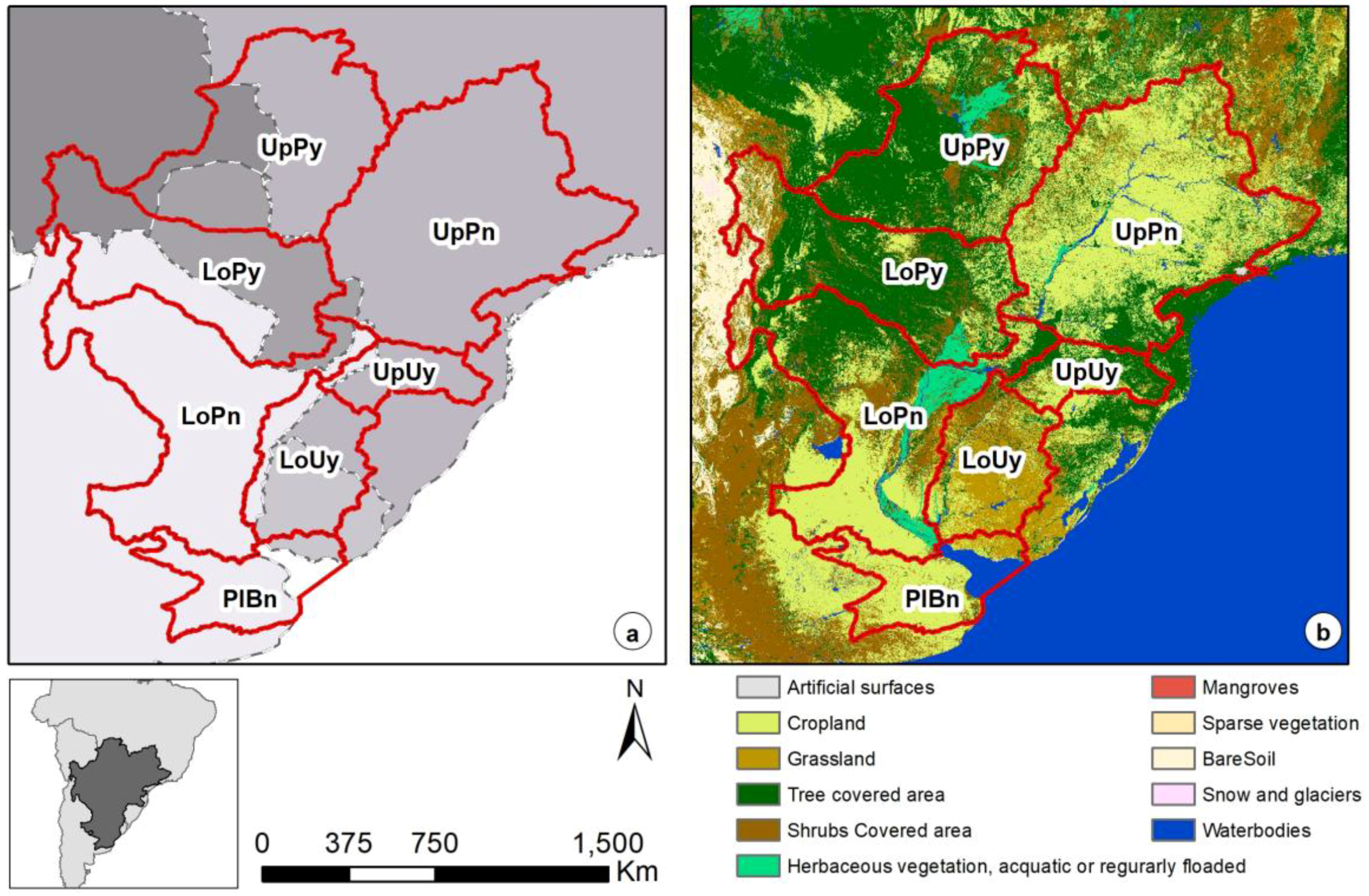
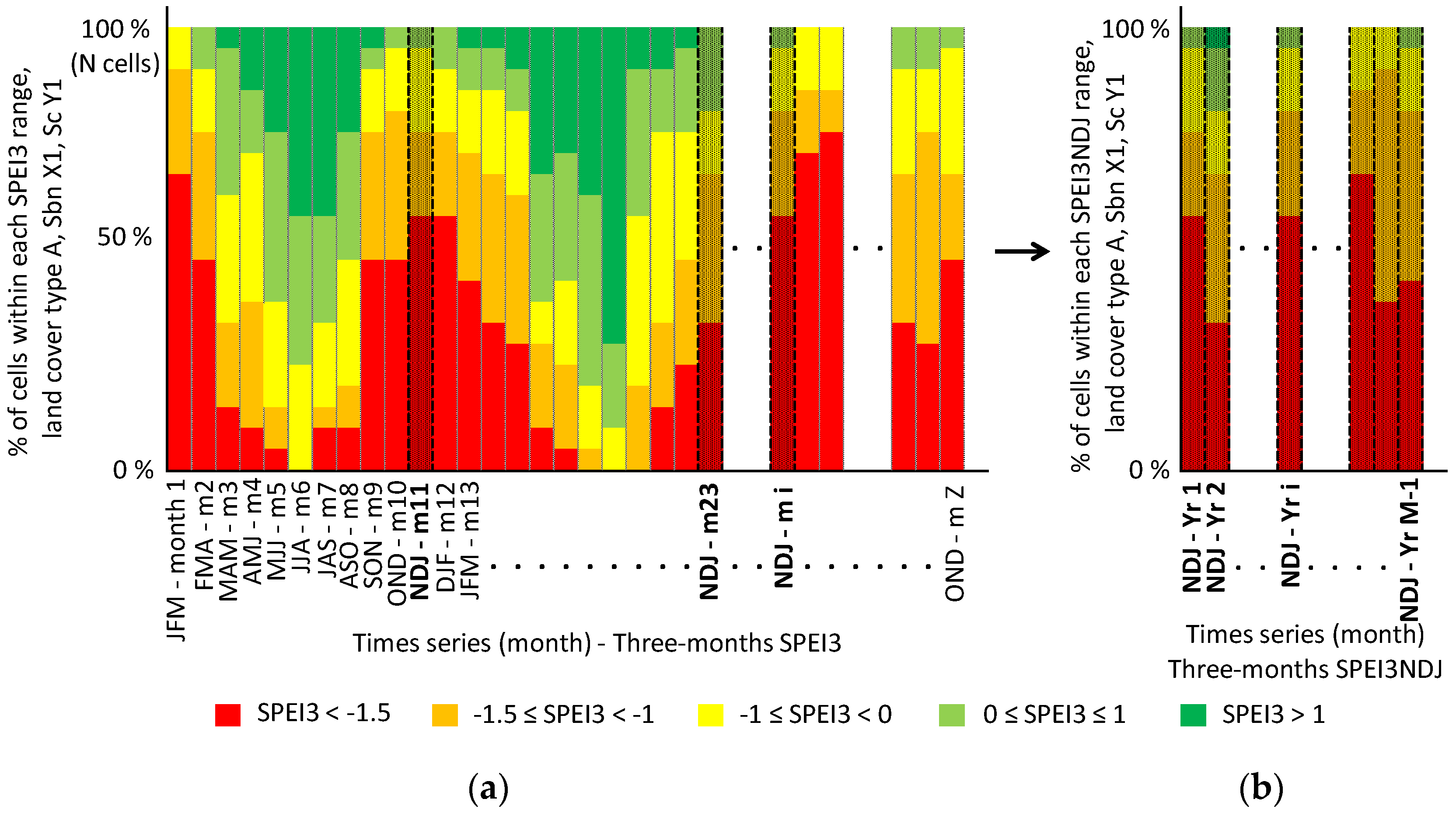


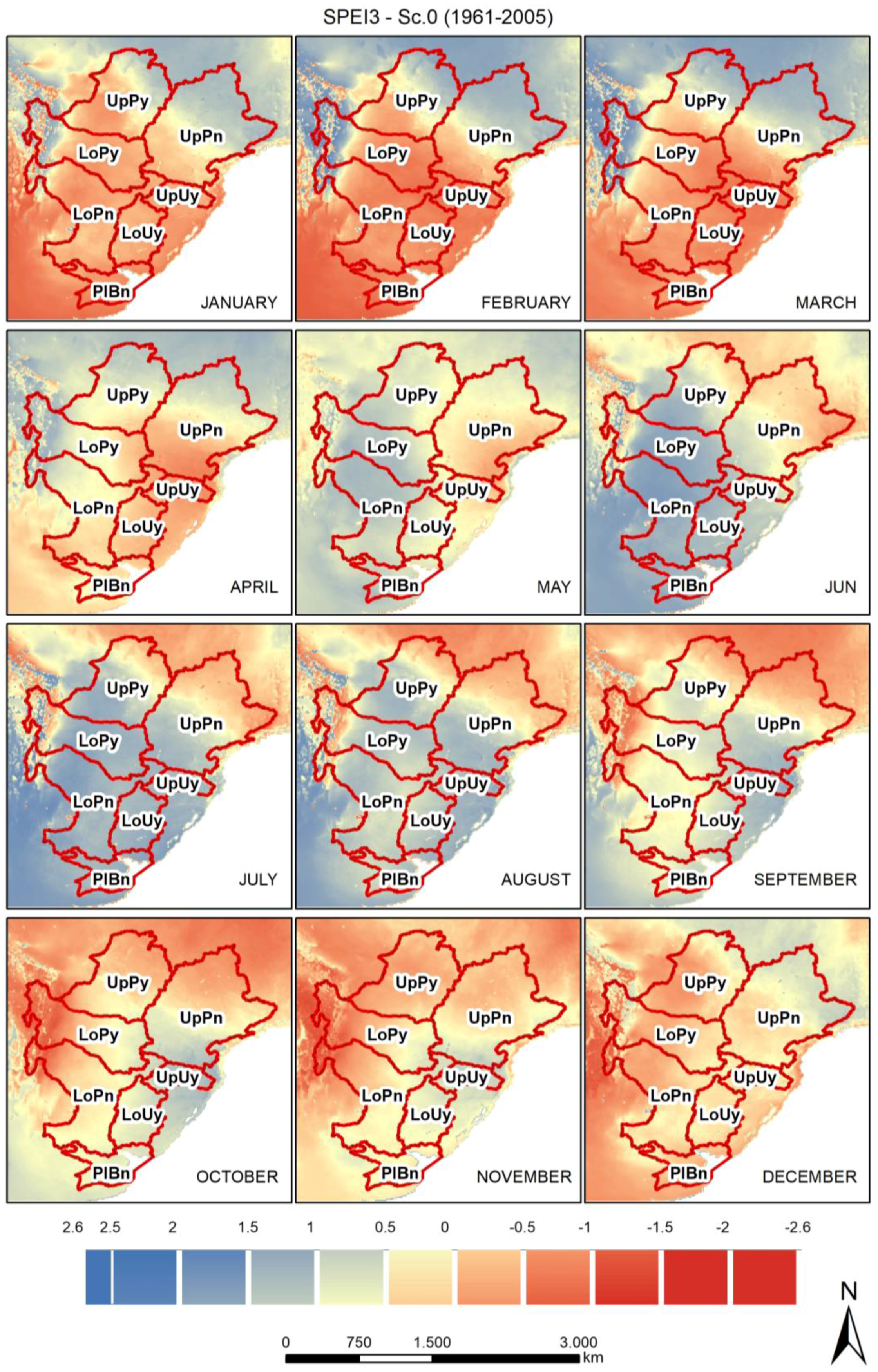

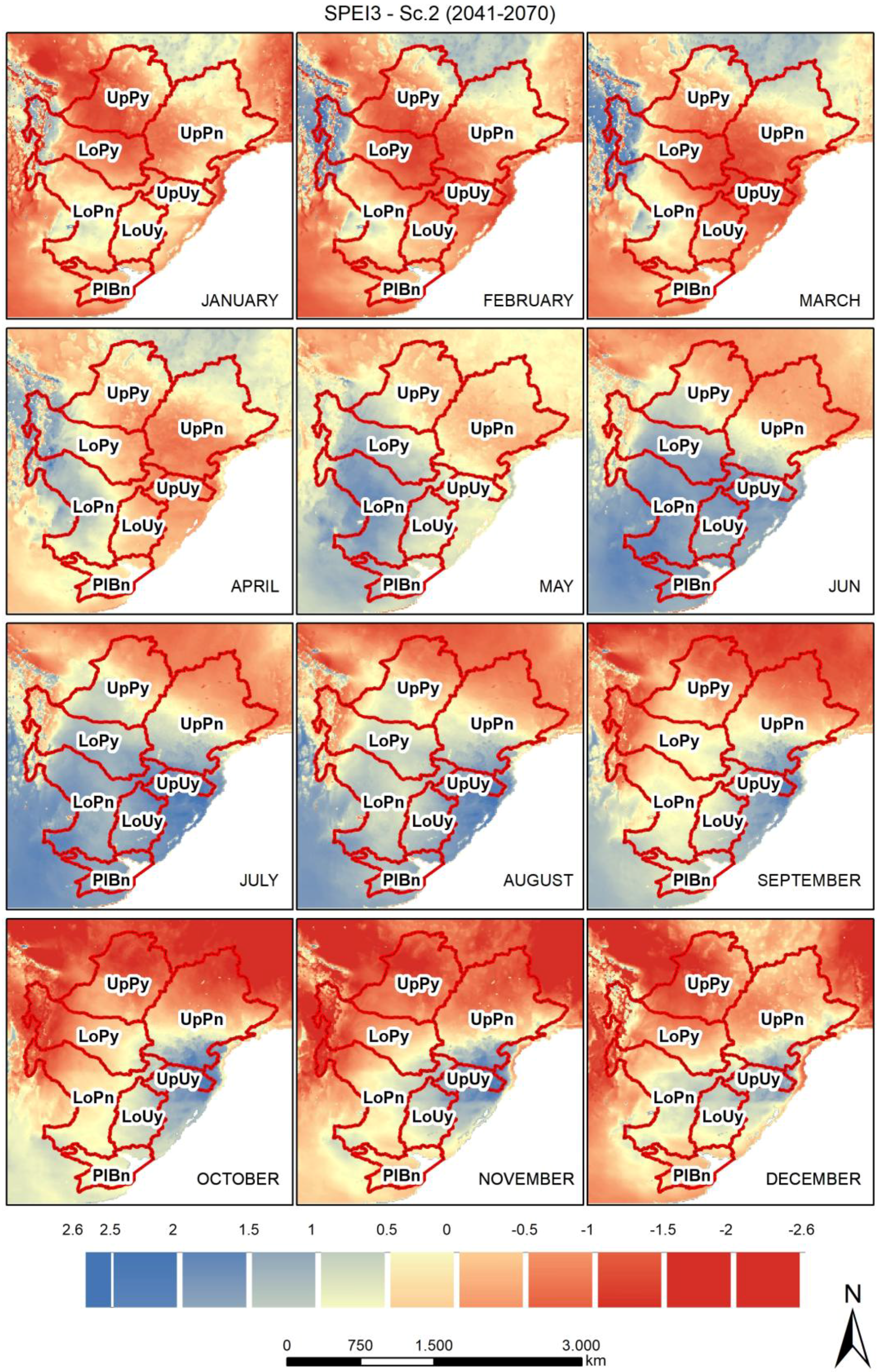
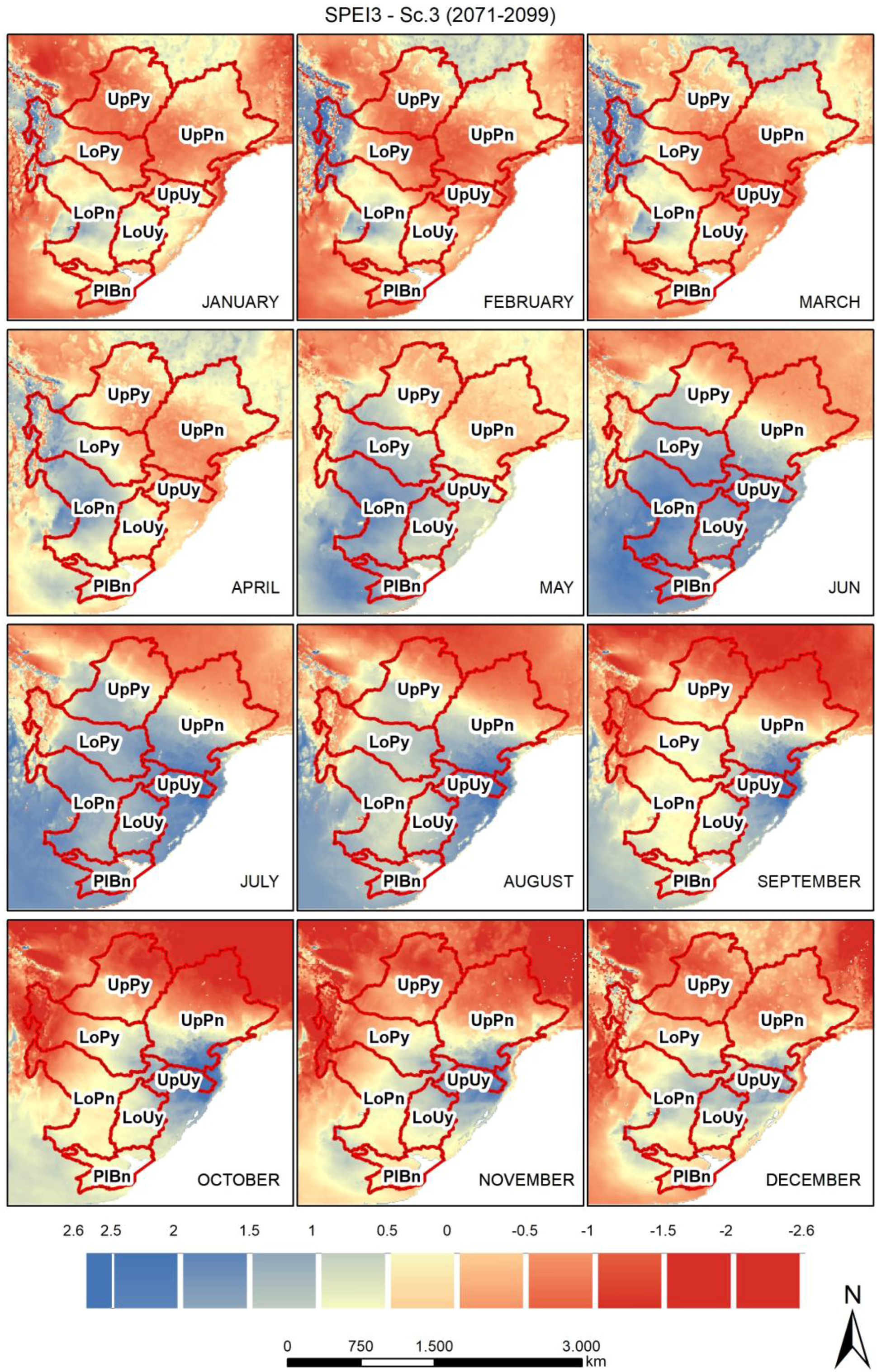

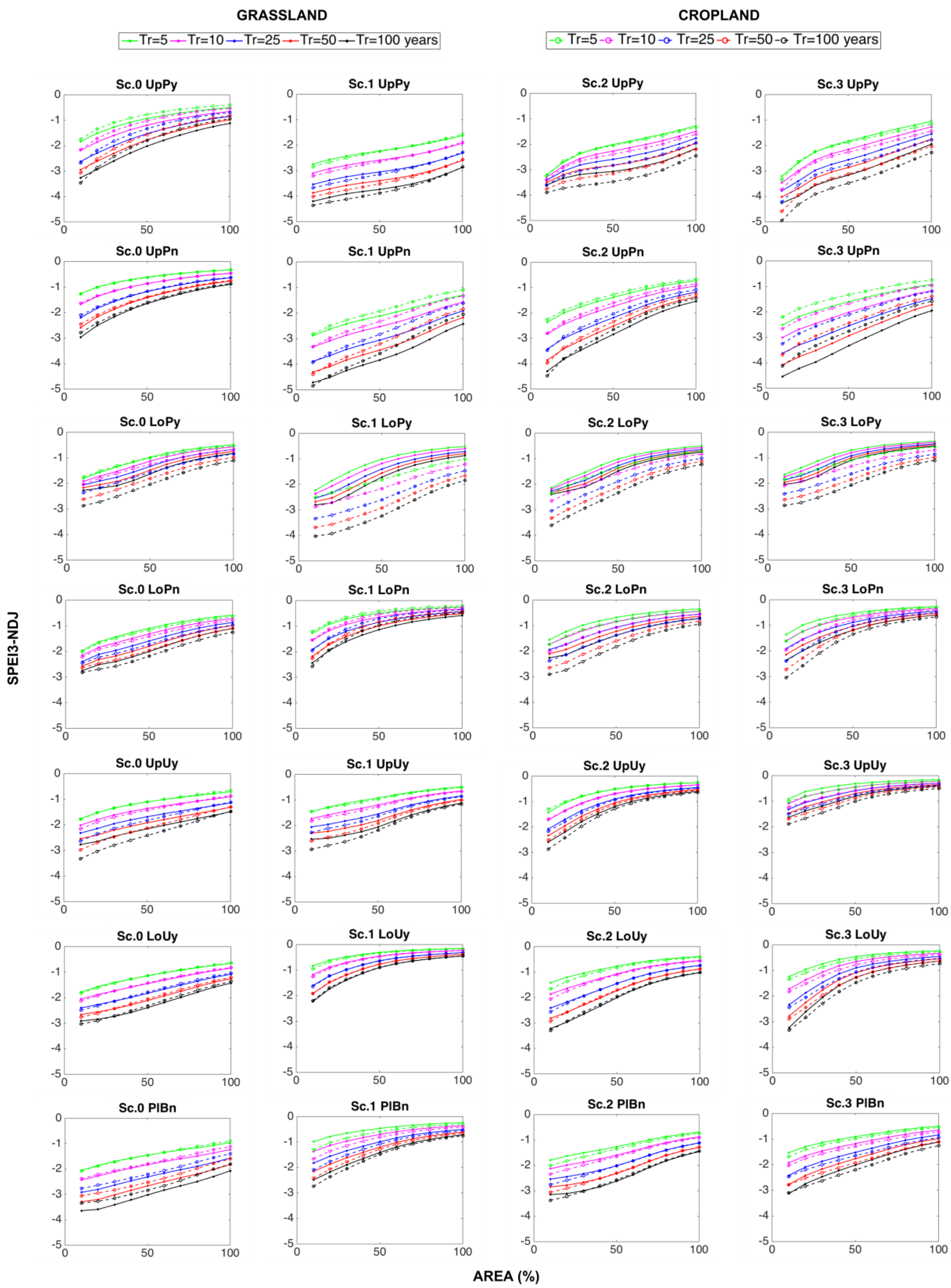
| Sub-Basin | Abbreviation | Area | % of Sub-Basin Area | |
|---|---|---|---|---|
| (km2) | Cropland | Grassland | ||
| Upper Paraguay | UpPy | 600,086 | 18 | 5 |
| Upper Paraná | UpPn | 899,628 | 68 | 4 |
| Lower Paraguay | LoPy | 520,068 | 12 | 5 |
| Lower Paraná | LoPn | 610,885 | 38 | 5 |
| Upper Uruguay | UpUy | 116,470 | 41 | 4 |
| Lower Uruguay | LoUy | 236,980 | 22 | 52 |
| La Plata River | PlBn | 190,112 | 75 | 10 |
| Total (km2) | 3,174,229 | |||
| Mean Annual P (mm/Year) | |||||||
| Climate Scenarios | UpPy | UpPn | LoPy | LoPn | UpUy | LoUy | PlBn |
| 1961–2005 | 1201 | 1792 | 1005 | 1032 | 2254 | 1609 | 1138 |
| 2011–2040 | 1042 | 1501 | 963 | 1112 | 2478 | 1795 | 1309 |
| 2041–2070 | 1167 | 1780 | 1105 | 1220 | 2781 | 1878 | 1279 |
| 2071–2099 | 1226 | 1848 | 1170 | 1270 | 2914 | 1961 | 1294 |
| Mean Annual PET (mm/Year) | |||||||
| Climate Scenarios | UpPy | UpPn | LoPy | LoPn | UpUy | LoUy | PlBn |
| 1961–2005 | 2579 | 2169 | 2243 | 2113 | 1825 | 1820 | 1780 |
| 2011–2040 | 2916 | 2532 | 2407 | 2074 | 1915 | 1802 | 1687 |
| 2041–2070 | 3008 | 2513 | 2466 | 2158 | 1962 | 1874 | 1809 |
| 2071–2099 | 2983 | 2527 | 2407 | 2126 | 1952 | 1863 | 1797 |
© 2017 by the authors. Licensee MDPI, Basel, Switzerland. This article is an open access article distributed under the terms and conditions of the Creative Commons Attribution (CC BY) license (http://creativecommons.org/licenses/by/4.0/).
Share and Cite
Sordo-Ward, A.; Bejarano, M.D.; Iglesias, A.; Asenjo, V.; Garrote, L. Analysis of Current and Future SPEI Droughts in the La Plata Basin Based on Results from the Regional Eta Climate Model. Water 2017, 9, 857. https://doi.org/10.3390/w9110857
Sordo-Ward A, Bejarano MD, Iglesias A, Asenjo V, Garrote L. Analysis of Current and Future SPEI Droughts in the La Plata Basin Based on Results from the Regional Eta Climate Model. Water. 2017; 9(11):857. https://doi.org/10.3390/w9110857
Chicago/Turabian StyleSordo-Ward, Alvaro, María Dolores Bejarano, Ana Iglesias, Víctor Asenjo, and Luis Garrote. 2017. "Analysis of Current and Future SPEI Droughts in the La Plata Basin Based on Results from the Regional Eta Climate Model" Water 9, no. 11: 857. https://doi.org/10.3390/w9110857






